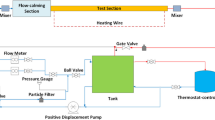Abstract
The processes of the phase change in boiling occur at the solid–liquid interface by heat transfer from a solid heating surface to the boiling liquid. The characteristic features of the heating surfaces are therefore of great interest to optimize the design of evaporators. The microstructure with all its peaks and cavities influences directly the wetting and rewetting conditions of the heated surface by the boiling liquid and hence bubble formation and heat transfer. The roughness structures of different evaporator copper tubes with 8 or 25 mm diameter are characterized quantitatively with regard to the cavities offered to nucleation. The surfaces of the heating elements are sandblasted by different means resulting in a stochastic microstructure. The surfaces are investigated by a three-dimensional contactless roughness measurement technique combining the stylus technique with the near field acoustic microscopy. The method opens the possibility to obtain results according to standard for practical applications and additionally delivers detailed information about the three-dimensional shape of each cavity within the surface investigated. The analysis of the microstructure implies the total number of cavities, their local and size distribution calculated by the method of the envelope area. The results of the surface analysis are linked to those of heat transfer and bubble formation discussed in a contribution by Kotthoff and Gorenflo.









Similar content being viewed by others
Abbreviations
- N :
-
number of potential nucleation sites (–)
- P a, P q, P p, P pm, P t, P z :
-
standardized roughness parameter acc. to DIN EN ISO 4287 (µm)
- R B :
-
roller radius for calculating the envelope curves or areas (µm)
- x, y, z :
-
coordinates of the topographies (µm)
- α:
-
heat transfer coefficient
- λc :
-
cut-off (mm)
- φ:
-
azimuthal angle (°)
- σ:
-
standard deviation
References
Kotthoff S, Gorenflo D (2006) Heat transfer and bubble formation on horizontal copper tubes with different diameters and roughness structures. In: Proceedings of 6th international conference on boiling heat transfer, Spoleto (Italy) 2006, and this special issue
Gorenflo D, Chandra U, Kotthoff S, Luke A (2004) Influence of thermophysical properties on pool boiling heat transfer of refrigerants. Int J Refrig 27:492–502
Gorenflo D, Kotthoff S, Chandra U (2004) New measurements of pool boiling heat transfer with hydrocarbons and other organics for update of VDI-Heat Atlas calculation method. In: Proceedings of 6th IIR-Gustav Lorentzen conference, paper 1/C/1.00, Glasgow, 2004
Kotthoff S, Chandra U, Gorenflo D, Luke A (2004) New measurements of pool boiling heat transfer for carbon dioxide in a wide temperature range. In: Proceedings of 6th IIR-Gustav Lorentzen conference, paper 2/A/3.30, Glasgow, 2004
Gorenflo D, Kotthoff S (2005) Influence of the fluid on pool boiling heat transfer of refrigerants and other organic substances. In: Proceedings of international institute of refrigeration commission B1 conference, Vicenza (Italy) 2005
Kotthoff S, Gorenflo D, Danger E, Luke A (2006) Heat transfer and bubble formation for pool boiling on tubes with basic surface modifications for enhancement. Int J Thermal Sci 45:492–502
Luke A (2003) Thermo- and fluid dynamic in boiling—connection between surface roughness, bubble formation and heat transfer. In: Proceedings of 5th international conference on boiling heat transfer, Montego Bay (Jamaica) 2003
Luke A (2006) Preparation, measurement and analysis of the microstructure of evaporator surfaces. Int J Thermal Sci 45:237–256
Gorenflo D (1993) Behältersieden; Abschnitt Hab; VDI-Wärmeatlas, 10th edn. Springer, Berlin 2006. cf. also: Pool boiling. Chapt. Ha. VDI-Heat Atlas, VDI-Verlag, Düsseldorf
Cooper MG (1984) Heat flow rates in saturated nucleate pool boiling—a wide ranging examination using reduced properties. Adv Heat Transf 16:157–239
Gorenflo D, Danger E, Luke A, Kotthoff S, Chandra U, Ranganayakulu C (2004) Bubble formation with pool boiling on tubes with or without basic surface modifications for enhancement. Int J Heat Fluid Flow 25:288–297
Stout KJ, Sullivan PJ, Dong WP, Mainsah E, Luo N, Zahouani H (1993) The development of methods for the characterisation of roughness in three dimensions. Publ. No. EUR 15178 EN
Stephan K (1964) Beitrag zur Thermodynamik des Wärmeüberganges beim Sieden. Abhandlung des D. Kältetech. Vereins Nr.18, C.F. Müller-Verlag, Karlsruhe
Acknowledgments
The author appreciates financial support of Deutsche Forschungsgemeinschaft.
Author information
Authors and Affiliations
Corresponding author
Rights and permissions
About this article
Cite this article
Luke, A. Preparation and analysis of different roughness structures for evaporator tubes. Heat Mass Transfer 45, 909–917 (2009). https://doi.org/10.1007/s00231-009-0481-1
Received:
Accepted:
Published:
Issue Date:
DOI: https://doi.org/10.1007/s00231-009-0481-1




